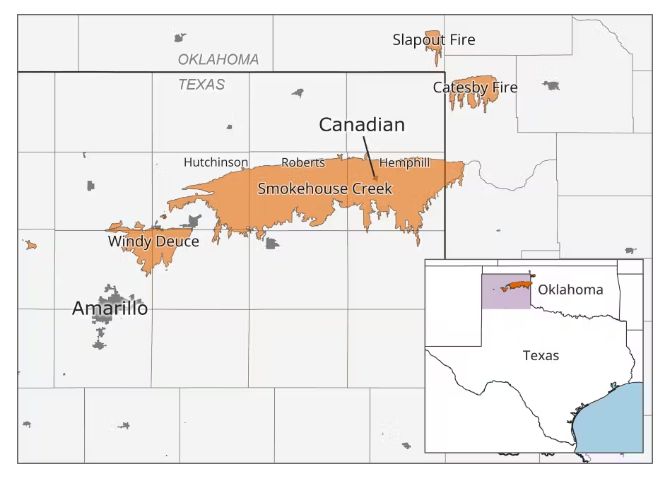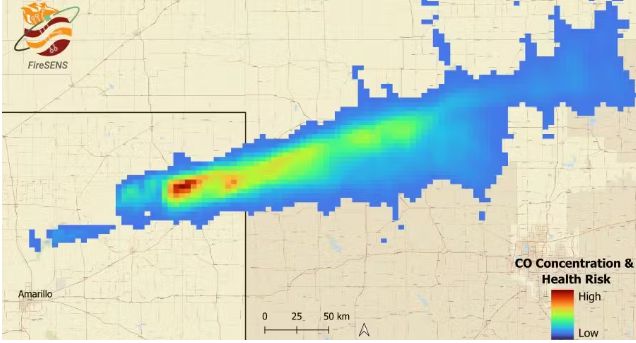How the 2024 Texas Panhandle wildfires highlight urgent lessons for managing climate change, population decline, and aging infrastructure.
Unprecedented wildfires raged across the Texas Panhandle in late February 2024, consuming over 510,000 hectares and destroying over 500 structures. The Smokehouse Creek Fire, the largest wildfire on record in Texas and the second largest in the U.S., burned 426,600 hectares (Figure 1). Ignited on February 26, 2024, in Hutchinson County, this wildfire rapidly spread across Hemphill and Roberts counties, including the town of Canadian. It cut power to 11,000 people and claimed the lives of three people and 15,000 cattle. Insured losses are expected to exceed $350 million, while the Investigative Committee on the Panhandle Wildfires has estimated that total economic loss to the Panhandle, including the economies it feeds, may ultimately exceed $1 billion.1

Figure 1: Extents of the largest fires in Texas and Oklahoma, between February and March 2024 (main panel, orange), with urban areas shown in gray. County borders shown in dark gray. Inset: The Panhandle region of Texas is highlighted with purple shading.
Data source: National Interagency Fire Center, WFIGS 2024 Interagency Fire Perimeters.
The Smokehouse Creek Fire highlights how climate change, human factors and poor land management exacerbate wildfire severity, offering five key insights for risk managers.
1. Aging power infrastructure and regulatory gaps fuel fire risk
Investigations revealed that the Smokehouse Creek Fire was ignited by downed power lines from a broken utility pole, flagged for replacement two weeks earlier.1 High winds on February 26, 2024,2 caused the line to fall onto dry grass, igniting the fire. This incident reflects the trend over the past two decades, where power lines have been a leading cause of wildfires in the Texas Panhandle.1
The fire spread rapidly, fueled by grasslands created through the federal Conservation Reserve Program, which incentivized the conversion of cultivated fields. Additionally, regulatory gaps permitted oil and gas operators to neglect fuel loads and electrical safety issues at well sites, where exposed wiring and dilapidated equipment posed significant fire risks. At least one oil and gas operator has filed for bankruptcy protection amid pending litigation.1
This situation opens the door for potential subrogation claims by insurers against utility companies, like recoveries obtained from California utilities such as Pacific Gas and Electric following the 2017 and 2018 wildfires. Concerns about current utility regulations and their ability to address rising risks from extreme weather have also sparked discussions about adopting enhanced measures, similar to California's mandated proactive power shutoffs during high-risk conditions.3
2. Population decline hampers wildfire response
The Texas Panhandle's steady population decline due to cultural and economic shifts has made it harder for authorities to manage and respond to recent wildfires. According to the Texas Emergency Management Council,4 fewer residents in the region means fewer volunteer firefighters and less local government tax revenue to support their volunteer fire departments (VFDs). The Panhandle is primarily supported by VFDs, and the sparse population in such a vast region limits the number of people available to spot the recent fires, many of which burned unnoticed for hours before being reported.
3. Texas faces an escalating threat from wildfires
Wildfire risk in Texas peaks during two specific periods: winter (February to April) and summer (August to October). Winter fires are fueled by cold fronts that bring dry air and high winds, while summer fires are often caused by high temperatures and prolonged droughts. Historically, the largest fires, including the Smokehouse Creek Fire in 2024, have occurred in winter.
Texas has seen a growing trend in wildfire magnitude and intensity, with fire seasons becoming longer and fires more destructive.5 Climate change is expected to increase wildfire frequency and severity in the state due to higher temperatures and more frequent droughts. Research shows U.S. wildfire seasons are already becoming longer and more intense, with Texas experiencing fire weather over twice as often today compared with the early 1970s.6
Urbanization exacerbates this challenge, with over 85% of wildfires in Texas igniting within two miles of communities.7 As more homes are built in the wildland-urban interface, prioritizing wildfire prevention and response is therefore crucial for both individuals and local authorities.
4. Recent fires add to protection gap challenges
Texas homeowners' insurance premiums are significantly higher than the national average and have been rising due to increased weather-related claims and climate change concerns. Governor Greg Abbott noted that many homes in rural Panhandle counties affected by recent fires had no insurance.8 Likewise, most fencing and cattle losses were uninsured unless landowners had special endorsements,1 with preliminary estimates indicating $123 million in agriculture and related economic losses from the Smokehouse Creek Fire.
With climate change expected to increase the frequency and severity of extreme weather events in Texas, the risk to uninsured homeowners will grow. This highlights the urgent need to improve insurance affordability and close the protection gap, particularly for vulnerable rural and lower-income populations. The Investigative Committee on the Panhandle wildfires1 recommended that the legislature evaluate ways to limit insurance premium increases for property and business owners affected by the fires and to make insurance coverage for fencing and cattle more widely available and affordable.
5. Monitoring hazardous aerosols will become increasingly important
Wildfire-induced air pollution has far-reaching impacts, as seen with Canada's 2023 wildfires, which affected over a third of the U.S. population. This degraded air equality has severe health consequences, contributing to approximately 340,000 premature deaths globally each year,9 a number projected to double by 2050 in North America.10
Remote sensing technology, using thermal and aerosol data from satellites, provides near real-time information on wildfire progression and hazardous aerosols such as carbon monoxide. This helps emergency management and healthcare providers allocate resources effectively, mitigating the severe respiratory and cardiovascular impacts of wildfire smoke, as evidenced by the Texas Panhandle wildfire's high carbon monoxide concentrations (Figure 2).

Figure 2. Carbon monoxide plume extent measured using the Sentinel-5P TROPOMI sensor on February 27, 2024. The areas indicated in red are experiencing the highest concentrations of CO and, consequently, the highest adverse health impacts.
Data source: RSS-Hydro
Implications for risk managers
Risk assessment
Evaluate wildfire exposure and vulnerability beyond the traditionally high-risk states on the U.S. West Coast. These assessments should consider how climate change is altering the frequency and severity of wildfire events.
Strategic preparedness and mitigation
Improve local mitigating actions, such as creating defensible space around structures. Insurers can support and incentivize these efforts through premium discounts and community programs.
Risk transfer solutions
Partner with natural catastrophe risk specialists to better quantify wildfire risks and develop innovative solutions for managing and transferring these risks, helping to close the protection gap.
Footnotes
1. King, K. et al. Investigative Committee on the Panhandle Wildfires: A report to the House of Representatives 89th Texas Legislature. (2024). Return to articleundo
2. National Weather Service. Two days of wind, dust and critical fire weather (26-27 February 2024). (2024). Return to articleundo
3. The Texas Tribune. Texas requires utilities to plan for emergencies. That didn't stop the Panhandle fires. (2024). Return to articleundo
4. Personal communication. (2024). Return to articleundo
5. Texas A&M Forest Service. Texas Fire Protection Plan. (2023). Return to articleundo
6. Climate Central. Burning Hot: 50 Years of Fire Weather Across the United States. (2024). Return to articleundo
7. Fire Information. Historical Fire Statistics. (2024). Return to articleundo
8. The Texas Tribune. Many homes burned in the Texas wildfires weren't insured, creating a steep path to recovery. (2024).> Return to articleundo
9. WWF. Fires, Forests and the Future: A Crisis Raging Out of Control? (2020). Return to articleundo
10. Ford, B. et al. Future fire impacts on smoke concentrations, visibility, and health in the contiguous United States. GeoHealth, 2(8), 229-247. (2018). Return to articleundo
Co-authored with Alice Pais de Castro - Technology Development Consultant, RSS-Hydro
The content of this article is intended to provide a general guide to the subject matter. Specialist advice should be sought about your specific circumstances.


